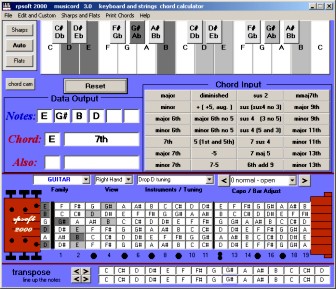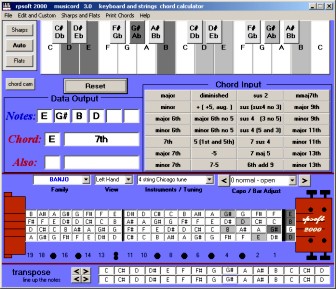| |
Forward
This page shows example usage of
rpsoft 2000 software "musicord" for retuned or detuned
stringed instrument applications. To
view the main page of this software and view its main characteristics,
view it here at: musicord.
Musicord version 3.0 handling of retuned musical instruments
As you likely are well aware, many
stringed instruments are not tuned to a "standard tuning". Many
talented musicians retune guitars, banjos, ukuleles or basses to make
playability better, or in some cases, to reduce tension on their
strings. Musicord contains many preset tunings for guitar, bass,
ukulele, banjo and others. If there is not a preset that suits
you, you can even customize the strings yourself. And then when
all of that customization is done - musicord will help show chord
fingering for the new setup.
The musicord chord calculator by
rpsoft 2000 addresses most stringed instruments of 4 to 6 strings.
Since it actually addresses "courses" of strings which is the actual
fingering, it will also do most normal tunings of 12 string guitar, 8
string mandolin or 12 string tiple (strings tuned in triplets) also, and
will provide either right hand or left hand viewing .
| |
 |
|
 |
|
| |
|
|
|
|
| |
The above shows the musicord screen for a
6 string guitar
with "Drop D" tuning and an E dominant 7th chord |
|
The above shows the musicord screen
also for a dominant E 7th chord
but this time for a left hand 4 string banjo with "Chicago" tuning |
|
Chords Recognized / Created
28 chords in all,
including: major, minor, major 6th, minor 6th, 7th, major 7th,
minor 7th, mmaj7th, major 9th, minor 9th, major 11th, minor 11th, major
13th, minor 13th,diminished, augmented (also called + or +5), major 6
with no 5, minor 6th with no 5, 5, -5, 7-5, sus 2, sus (sus 4 no 3),
sus4 (3 no 5), sus 4 (5 and 3), 7 sus 4, 7 maj 5, 6th add 9.
Stored Instrument Presets and Tuning (available
for right or left hand viewing)
Some of the more common preset tunings
are available for the following instruments: Guitar family, bass
family, ukulele, banjo family, violin family, mandolin family, cittern,
bouzouki, lute, tiple, and more. Note that some of the preset
tunings include instrument variations such as tenor (4 string) guitar, 5
string and 4 string banjo, 4 string and 5 string citterns, and the like.
(note that for instruments that have string "pairs" or "triplets" and
hence are tuned in "courses" that musicord shows the fingering and not
all strings. Hence an 8 string mandolin whose strings are tuned as
pairs will show up as a 4 string instrument. A 12 string guitar
tuned in pairs will show up as a 6 string guitar. A 12 string
tiple tuned in string triplets will show up as a 4 string instrument).
Unique Tunings and
Storage of Favorite Tunings
If none of the above preset tunings will
work for you, Musicord also allows you to adjust each string to any
chromatic note you wish. Simply you would click with your mouse on
the string you wish to change on the note nearest the neck, and then you
are able to change it to any chromatic note. If you have a number
of custom tunings or even a number of custom tuned instruments, musicord
will allow you to setup a "custom" instrument family where your special
tunings are indexed and ready for use.
Fingering Options
Dark gray areas show
the primary (lowest possible) fingering. Light gray areas show
duplicate fingering that could be substituted if the person wishes. For
example, one could substitute a light gray C note fingering for a dark
gray C note fingering. Substitutes may make the fingering easier,
or make for a better sound in the particular circumstance.
Options allow one to
see fingerings down the banjo neck by using a “capo”
option.
Notes to Chords
One can also enter
notes on the piano keyboard or the guitar / stringed instrument fret board, and then see if
the software program recognizes the chord. If it does, the program
will show the chord name, (piano chord or banjo chord) and any
alternates, in the data area.
What if one wants to
see fingering for a combination of notes that are not one of the
28 listed chords? Entering the notes on the piano keyboard will
show the note fingering on the stringed instrument fret board even if it is not one
of the 28 chords.
More Options
Even more options,
including printing, making custom tunings or instruments shown on the
main musicord page. To see these,
click here.
Relevant Links
(includes this page)
General:
Musicord Software- main page,
Left Hand Chord Example,
Retuned Strings Example
Musical Instrument
Families
Keyboard / Piano,
Guitar / Tiple,
Bass Guitar,
Ukulele,
Banjo, Mandolin / Bouzouki /
Cittern,
Violin / Fiddle / Viola / Cello,
Steel Guitar / Dobro,
Lute / Oud / Cumbus
Click Here for
eBook Info on One Person Band Recording
If you wish to Download and Try,
Click
here for the Download page. Note that you must also agree with our
rules and liability exclusion.
To rpsoft 2000 software
|
|